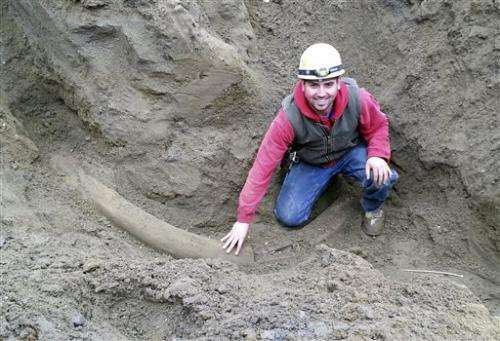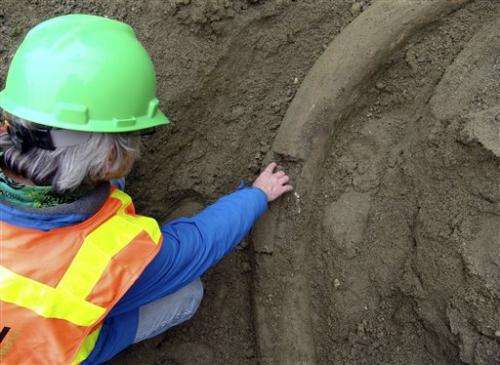Owner lets museum to dig up Seattle mammoth tusk

The fate of the mammoth tusk found at a construction site in downtown Seattle this week was entirely up to the landowner, a national expert said Thursday.
Washington state has no laws governing finds of this type. And Jack Horner of the Museum of the Rockies and Montana State University said that is true anywhere in the United States.
The landowner decided to donate the tusk to the Burke Museum of Natural History and Culture at the University of Washington, just as Horner hoped would happen.
It's a relatively rare find and should be preserved for educational reasons, so children will know mammoth elephants once lived in Seattle, he said.
"A lot of times, people think these things are worth a lot of money," Horner said. Their true value is educational, not what someone can sell a tusk for on eBay, he said.
As paleontologists and graduate students began carefully digging away the dirt around the tusk on Thursday afternoon, Julie Stein, executive director of the museum, said AMLI Residential has been wonderful to work with.
Scott Koppelman, senior vice president of AMLI Residential, said that after contractors found the fossil buried about 30 feet (nine meters) below street level, the company turned quickly to the Burke museum for assistance.

Mammoth elephants lived all over the United States and Europe in ancient times, but finding a tusk or any part of those animals is rare, Horner and other experts said.
"We don't find them every year or even every five years," he said. In most cases, artifacts found at construction sites are destroyed by a big machine before anyone even notices them, Horner said.

Discoveries of animal remains from the Ice Age are less common than human remains in western Washington. Preservation of bone and tusks depends on the environmental conditions, such as the water table, the acidity of the soil and how deeply the object was buried, Brooks said.
"A lot of time, teeth preserve better than other bones," she said, likening tusks to teeth. Teeth and tusks are what she and the scientists she works with consider "biological rock," Brooks said.

The last big find of an ancient animal of this sort in western Washington happened in 1977, when a Mastodon tusk was found near Sequim, Washington, on the Olympic Peninsula.
Mammoths and Mastodons are related and probably roamed the Earth around the same time. Both were very large and hairy. Mammoths and modern-day elephants are members of the same biological family.

Scientists at the Burke believe this tusk came from a Columbian mammoth, which is the Washington state fossil. The tusk, which could be as large as 8 feet long, is expected to be the largest and most intact mammoth tusk ever found in the Seattle area.

© 2014 The Associated Press. All rights reserved.




















